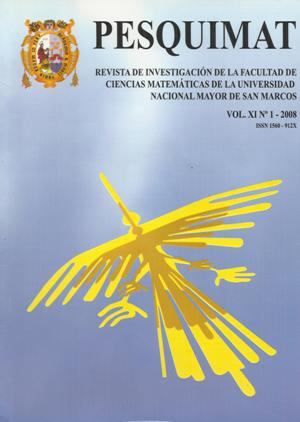DETERMINACIÓN DE PATRONES DE VARIACIÓN MORFOLÓGICA DEL GÉNERO MINTHOSTACHYS EN UNCHUS y CAJATAMBO, MEDIANTE MÉTODOS ESTADÍSTICOS MULTIVARIANTES DE REDUCCIÓN DE DATOS
DOI:
https://doi.org/10.15381/pes.v11i1.9456Keywords:
Principal Component Analysis, Principal Component Analysis Generalised, T2 Hotellinq, Minthostachys, Cajatambo, Unchus.Abstract
The study was conducted in the town of Unchus and in the district of Cajatambo in the departments of Ancash and Lima respectively. Both places are in high Andean territory. The objective of this study was to conduct a comparative analysis of the characterization of gender Minthostachys (muña), from samples collected during the years 2004 and 2005, through graphic representations of the original variables belonging to space R5to R2 using A nalysis Factorial (Jotinson, 2000; Seber, 1984 et al), Principal Component Analysis and Principal Component Analysis Generalised (Flury, 1983; De Paz and Comez, 2002). The morphologyc variables studies were conducted in the Department
of Ethnobotany and conomic Botany of the Natural History Museum and the identification of species was conducted in the Herbarium USM using the Classification System Cronquist. The graphics using variables generated by the principal component analysis and Principal Component Analysis Generalised, allow to identify three different species of Minthostachys in communities of
Unchus and Cajatambo. The results are confirmed by T2 de Hotelling.
Downloads
Published
Issue
Section
License
Copyright (c) 2008 Doris Gómez Ticerán, Olga Solano Dávila, Joaquina Adelaida Albán Castillo, Camilo Andrés Vásquez Araujo, Jaime Arsenio Vásquez Esquivel, Yakov Mario Quinteros Gómez

This work is licensed under a Creative Commons Attribution-NonCommercial-ShareAlike 4.0 International License.
THE AUTHORS RETAIN THEIR RIGHTS:
a) The authors retain their trademark and patent rights, and also on any process or procedure described in the article.
b) The authors retain the right to share, copy, distribute, execute and publicly communicate the article published in Pesquimat magazine (for example, place it in an institutional repository or publish it in a book), with recognition of its initial publication in the Pesquimat magazine.
c) The authors retain the right to make a later publication of their work, to use the article or any part of it (for example: a compilation of their works, notes for conferences, thesis, or for a book), provided that they indicate the source of publication (authors of the work, magazine, volume, number and date).






